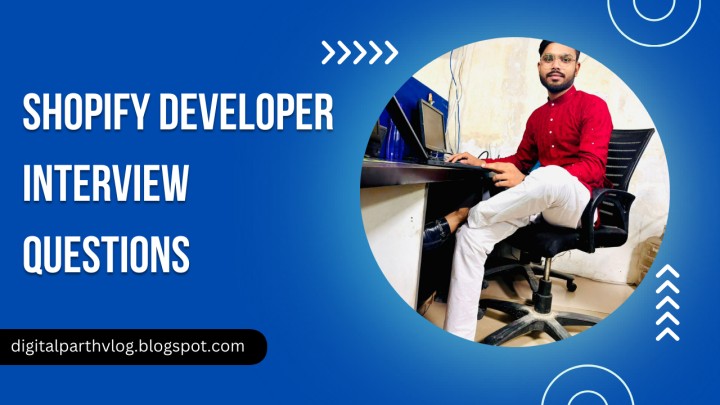Shopify development is a growing field, and landing a job as a Shopify developer requires a strong understanding of Liquid, APIs, themes, and more. Below are the top 25 Shopify Developer interview questions along with expert answers to help you prepare.
Basic Shopify Development Questions
1. What is Shopify?
Answer: Shopify is a cloud-based eCommerce platform that allows users to create, customize, and manage online stores. It provides tools for product management, payments, shipping, and customer engagement.
2. What are the key features of Shopify?
Answer: Shopify offers various features, including:
- User-friendly store setup
- Customizable themes
- Payment gateway integration
- Mobile responsiveness
- SEO optimization
- Shopify App Store for third-party plugins
3. What is Shopify Liquid?
Answer: Liquid is Shopify’s templating language used to build themes. It enables developers to dynamically display content by using logic and variables.
4. How does Shopify differ from other eCommerce platforms?
Answer: Shopify is fully hosted, beginner-friendly, and has built-in tools for SEO, marketing, and payment processing, whereas platforms like WooCommerce require self-hosting and more technical setup.
Shopify Theme Development Questions
5. What is a Shopify theme, and how is it structured?
Answer: A Shopify theme is a collection of templates, styles, and scripts that define a store’s appearance. It consists of Liquid files, CSS, JavaScript, and assets stored in the theme directory.
6. How can you customize a Shopify theme?
Answer: Themes can be customized using:
- Shopify Theme Editor
- Liquid code modification
- CSS and JavaScript for styling and interactions
- Custom sections and blocks
7. What are Shopify sections and blocks?
Answer: Sections are customizable theme elements that allow users to add content dynamically. Blocks are individual components within sections that can be rearranged for greater flexibility.
Shopify App Development Questions
8. What are Shopify Apps?
Answer: Shopify Apps extend store functionality. They are built using Shopify APIs and can be installed from the Shopify App Store or developed as custom private apps.
9. What are the different types of Shopify Apps?
Answer: Shopify has three types of apps:
- Public Apps: Available in the Shopify App Store
- Private Apps: Created for a single Shopify store
- Custom Apps: Used for specific business needs without being listed on the App Store
10. How do you integrate Shopify APIs?
Answer: Shopify APIs can be integrated using REST or GraphQL to access products, orders, customers, and more. Authentication is done using API keys or OAuth.
Advanced Shopify Development Questions
11. How do you migrate a store to Shopify?
Answer: Migration involves:
- Exporting data from the existing platform
- Importing products, customers, and orders
- Configuring design and settings
- Testing and launching the store
12. How does Shopify handle payments?
Answer: Shopify offers Shopify Payments and supports third-party payment gateways like PayPal, Stripe, and Authorize.net.
13. What is Shopify’s checkout process?
Answer: Shopify uses a secure, PCI-compliant checkout process where users enter shipping, payment, and order details before completing a purchase.
Performance Optimization & SEO Questions
14. How do you optimize a Shopify store for SEO?
Answer: SEO optimization includes:
- Using clean URL structures
- Optimizing meta titles and descriptions
- Adding alt text to images
- Improving site speed
- Using structured data
15. How can you improve Shopify store speed?
Answer: Improve speed by:
- Compressing images
- Reducing app usage
- Minifying CSS/JS files
- Using a fast theme
Security & Maintenance Questions
16. How does Shopify ensure security?
Answer: Shopify is PCI-DSS compliant, offers SSL certificates, and uses fraud analysis tools to secure transactions.
17. What is the importance of Shopify backups?
Answer: Backups prevent data loss. Shopify does not offer automatic backups, so using third-party apps or manual exports is recommended.
Troubleshooting & Best Practices Questions
18. How do you troubleshoot Liquid errors?
Answer: Debugging can be done using:
- Shopify’s error messages
- Logging errors in templates
- Checking variable outputs using {{ variable }}
19. What is the Shopify Partner Program?
Answer: It’s a program for developers, designers, and marketers to create apps, themes, or stores for clients and earn commissions.
20. How do you handle Shopify store migrations?
Answer: Use Shopify’s import tools, third-party apps, or API integrations to transfer data efficiently.
Miscellaneous Questions
21. Can you use Shopify with headless commerce?
Answer: Yes, using Shopify’s Storefront API, developers can create headless commerce experiences with React, Vue, or other frameworks.
22. How do you manage inventory in Shopify?
Answer: Inventory can be managed via the Shopify admin panel, bulk imports, or API-based automation.
23. What are Shopify metafields?
Answer: Metafields store additional information about products, customers, and orders beyond standard Shopify fields.
24. How do you create a Shopify store from scratch?
Answer: Steps include:
- Registering a Shopify account
- Selecting a theme
- Adding products and collections
- Configuring settings
- Launching the store
25. What are Shopify scripts?
Answer: Shopify Scripts allow developers to customize checkout processes and discounts using Ruby.
By preparing for these questions, you can increase your chances of succeeding in a Shopify Developer interview. Keep refining your skills in Liquid, Shopify API, and store optimization to stay ahead in the field.

Comments
Post a Comment